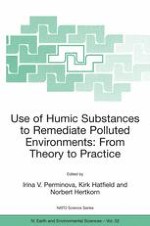2005 | OriginalPaper | Buchkapitel
Impact of Humic Substances on Plants in Polluted Environments: Implications for Phytoremediation Technologies
verfasst von : M.M. Kharytonov, R.A. Karbonyuk, M.P. Bulgakova
Erschienen in: Use of Humic Substances to Remediate Polluted Environments: From Theory to Practice
Verlag: Springer Netherlands
Aktivieren Sie unsere intelligente Suche, um passende Fachinhalte oder Patente zu finden.
Wählen Sie Textabschnitte aus um mit Künstlicher Intelligenz passenden Patente zu finden. powered by
Markieren Sie Textabschnitte, um KI-gestützt weitere passende Inhalte zu finden. powered by
There is a great variety of soil types in Ukraine. Recently, some industrial regions of the country have encountered the problem of soil degradation due to technogenic pollution. Technogenic soil contamination with heavy metals has been found in the mining and metallurgical regions in the southeast part of Ukraine. Within Ukraine, 79% of all atmospheric emissions occur in the Donetsk-Pridneprovsky region. In the Dniepropetrovsk region, the concentration of mining and metallurgical production exceeds average indexes 7 to 10 times.
The zone of radioactive anomaly caused by the Chernobyl disaster is characterized by complex pollution of the environment. The objective of our work was to elaborate methods of soil detoxification with humates and to reduce the risk of plant contamination with heavy metals, radionuclides, and herbicides. Studies aimed to decrease the negative impact from industrial pollution of soils by heavy metals and radionuclides were conducted in the areas of industrial air and soil pollution in various areas of Ukraine. At the same time the risk of increased total toxicity from the combination of heavy metals and some herbicides presented in the local soils was also taken into account.
In the laboratory experiment a humic preparation “huminate” promoted benzoxazinones formation in the barley. Benzoxazinones formation further led to a 20% decrease of atrazine content in the seedlings. Introduction of humate preparation into the soil reduced also atrazine concentration to the trace concentrations. The protective action of peat, coal-derived humates and biohumus in relation to toxicity of heavy metals to plants was also studied.
A combination of two kinds of trials (introduction in soil and treatment of seeds before planting) for humic substance application led, as a rule, to increase of the barley productivity. The introduction of the vermicompost product (biohumus) into the soil reduced the negative heavy metals impact and the atrazine after-effect on barley growth. In particular, the introduction of biohumus and preliminarily processed poultry dung into the soil increased the barley yield by 12–27%.
